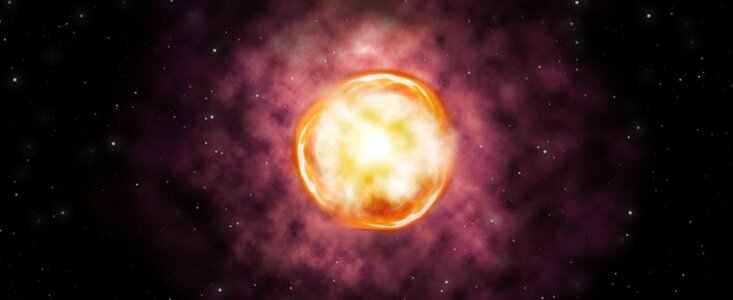Total Annihilation for Supermassive Stars
15 Agosto 2019
A renegade star exploding in a distant galaxy has forced astronomers to set aside decades of research and focus on a new breed of supernova that can utterly annihilate its parent star — leaving no remnant behind. The signature event, something astronomers had never witnessed before, may represent the way in which the most massive stars in the Universe, including the first stars, die.
The European Space Agency’s (ESA) Gaia satellite first noticed the supernova, known as SN 2016iet, on November 14, 2016. Three years of intensive follow-up observations with a variety of telescopes, including the Gemini North telescope and its Multi-Object Spectrograph on Maunakea in Hawaiʻi, the CfA | Harvard & Smithsonian’s MMT Observatory located at the Fred Lawrence Whipple Observatory in Amado, AZ, and the Magellan Telescopes at the Las Campanas Observatory in Chile, provided crucial perspectives on the object’s distance and composition.
“The Gemini data provided a deeper look at the supernova than any of our other observations,” said Edo Berger of the Harvard-Smithsonian Center for Astrophysics and a member of the investigation’s team. “This allowed us to study SN 2016iet more than 800 days after its discovery, when it had dimmed to one-hundredth of its peak brightness.”
Chris Davis, program director at the National Science Foundation (NSF), one of Gemini’s sponsoring agencies, added, “These remarkable Gemini observations demonstrate the importance of studying the ever-changing Universe. Searching the skies for sudden explosive events, quickly observing them and, just as importantly, being able to monitor them over days, weeks, months, and sometimes even years is critical to getting the whole picture. In just a few years, NSF’s Large Synoptic Survey Telescope will uncover thousands of these events, and Gemini is well positioned to do the crucial follow-up work.”
Más Información
NSF’s NOIRLab (National Optical-Infrared Astronomy Research Laboratory), the US center for ground-based optical-infrared astronomy, operates the international Gemini Observatory (a facility of NSF, NRC–Canada, ANID–Chile, MCTIC–Brazil, MINCyT–Argentina, and KASI–Republic of Korea), Kitt Peak National Observatory (KPNO), Cerro Tololo Inter-American Observatory (CTIO), the Community Science and Data Center (CSDC), and Vera C. Rubin Observatory (in cooperation with DOE’s SLAC National Accelerator Laboratory). It is managed by the Association of Universities for Research in Astronomy (AURA) under a cooperative agreement with NSF and is headquartered in Tucson, Arizona. The astronomical community is honored to have the opportunity to conduct astronomical research on Iolkam Du’ag (Kitt Peak) in Arizona, on Maunakea in Hawaiʻi, and on Cerro Tololo and Cerro Pachón in Chile. We recognize and acknowledge the very significant cultural role and reverence that these sites have to the Tohono O'odham Nation, to the Native Hawaiian community, and to the local communities in Chile, respectively.
About the Release
| Release No.: | noirlab1905 |
| Facility: | Gemini North |
| Instruments: | GMOS-N |
| Science data: | 2019ApJ...881...87G |


